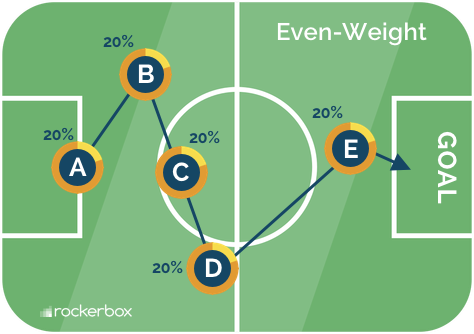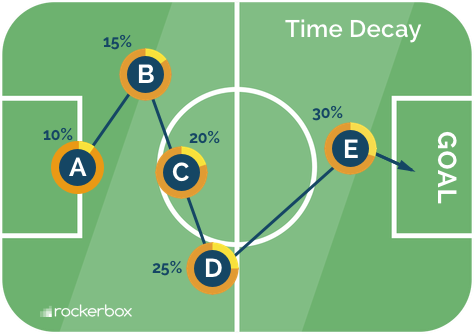Multi-Touch Attribution (MTA) models are a type of marketing analytics method used to identify and measure the impact of individual marketing channels or campaigns on customer acquisition and sales. MTA models provide a comprehensive view of how potential customers interact with a business’s marketing efforts across different channels, devices, and touchpoints before completing a purchase or taking a desired action. By looking at these touchpoints, businesses can better understand which channels are most effective in driving customers to convert and thus optimize the customer journey for the future.
The most common multi-touch attribution models are linear, time decay, position-based, and data-driven models. These models vary in complexity and accuracy and each one has its own strengths and weaknesses.
Linear or even-weight multi-touch attribution models
Linear or even-weight models assume that all channels or touchpoints in the customer journey are equal in terms of their impact on the conversion. This simple and straightforward model assigns equal credit to all touchpoints that a customer interacted with before converting. It is the most basic model, but is also the least accurate of the MTA models.
In a soccer game, all players would receive the same amount of credit for scoring a goal. Even-weight is more sophisticated than a single-touch model—it doesn’t ignore all the touchpoints in the middle of the conversion path. The downside is that not all touchpoints are created equal. This model essentially says that every soccer player gets awarded for participating, which is unfair to the rockstars..

Time decay multi-touch attribution models
Time decay models, also known as recency models, assign more credit to the touchpoints that are closest to the conversion. This model is useful for businesses that want to prioritize recent interactions over older ones. It is better at capturing the impact of touchpoints in the customer journey, but it can still miss out on the impact of touchpoints further back in the journey.
With a time decay model, the soccer players closest to the goalpost receive the most credit. While time decay acknowledges that not all touchpoints are created equal, it’s still flawed. Let’s say someone reads a powerful article on your website that makes them want your product. The next day, this person is retargeted with an ad. Is the ad really doing more heavy lifting in earning the conversion?

Position-based MTA models
(aka U-Shape)
Position-based models are more sophisticated than linear or time decay models and are used to assign different levels of credit to different marketing channels. This model takes into account the position of the touchpoint within the customer journey and assigns the greatest amount of credit to the first and last touchpoints, with the remaining touchpoints receiving a lesser amount of credit. This model is useful for businesses that want to prioritize the touchpoints that are most likely to influence the customer’s purchase decision.
In the soccer game, Players A and E receive the most credit while the remaining players are acknowledged to a lesser degree, equally. If the touchpoint that grabs customers’ initial interest and the touchpoint that ultimately converts them are deemed most important, this model works well. The drawback is that if your business really needs a second or third touchpoint to convert a customer, this model won’t properly acknowledge it.
.png?width=474&height=334&name=position-based%20attribution%20(post%20upgrade).png)
Data-driven or machine learning MTA models
Data-driven or machine learning models are the most advanced and accurate of the MTA models. They use machine learning and artificial intelligence to analyze customer journeys and identify the channels and touchpoints that have the greatest impact on conversion. This model is best suited for businesses that have the resources to invest in data-driven marketing analytics and want to get the most accurate view of how their marketing efforts are influencing customer behavior.
In the soccer game, each player’s value would be determined based on their performance throughout multiple plays. Implementing a machine learning MTA model used to be challenging. For instance, it requires having access to the historical data of your marketing activities, as well as a tool to analyze performance patterns. Challenges aside, this model brings you a lot closer to determining the true value of each marketing touchpoint.

In conclusion, MTA models are a useful tool for businesses that want to understand how customers interact with their marketing efforts across different channels and touchpoints. The most common MTA models are linear, time decay, position-based, and data-driven models, each of which has its own strengths and weaknesses. Businesses should consider their specific needs and resources when choosing an MTA model to ensure they are getting the most accurate view of their marketing performance.
 Google
Google Facebook
Facebook Instagram
Instagram TikTok
TikTok Snapchat
Snapchat Reddit
Reddit Pinterest
Pinterest


.png?width=50&height=56&name=medal%20(1).png)



